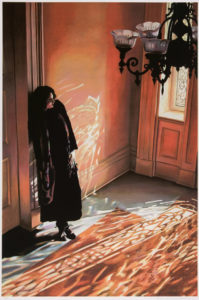Adrian Deckbar
New Orleans artist Adrian Deckbar's photo realistic paintings are based on the landscape that surrounds her and often portray Louisiana swamps and wetlands.

Courtesy of Adrian Deckbar
In the Foyer. Deckbar, Adrian (Artist)
For thirty-five years, Adrian Deckbar has painted highly contrasted room interiors with models illuminated by soft, warm light. These hyperrealist and romantic paintings often resembled still images from a movie set, caught between dramatic moments.
Born in New Orleans on September 6, 1950, Deckbar studied art at Southwestern Louisiana University (now the University of Louisiana at Lafayette) from 1968 to 1973 with the late Southwest Louisiana landscape painter Elemore Morgan Jr. In 1974, she earned a master’s degree at San Francisco State University, where she studied under Robert Bechtle, the renowned photorealist. In 1981, she received a master of fine arts degree in art at Tulane University.
The natural landscape is a relatively new source of inspiration for Deckbar, who has taught art at Tulane University and the New Orleans Academy of Fine Arts. Actually, this was Deckbar’s intent. Like a stage director, she set up her scenes and lighting, positioned her models, and created the actor’s motivation to capture a desired mood. She then photographed the setting, projected the image on a large canvas, and sketched in the composition. “I was not only attempting to paint their forms,” she explained, “but something about their being, their existence.” But in the end, Deckbar felt she had taken figure painting as far as she could. “I felt it was becoming formulaic and I didn’t feel passionate about it anymore.”
Her moody room scenes began to change in the mid-1990s during a trip to the Amalfi Coast of Italy, where Deckbar photographed visual elements in the Italian landscape as props for later paintings. Back in her New Orleans studio, she moved her models closer to windows that looked out into the natural world. She also photographed models that she superimposed on the Italian landscape. In 1999, she took that European influence a bit further by photographing models in old New Orleans cafés and coffee shops. A couple of years later, she traveled to France to photograph people sitting in outdoor cafes. “It didn’t gel artistically,” she says. “It was unsatisfying to me. I decided I didn’t need to travel to Europe to find subject matter. I didn’t want my paintings to be clichés and that’s where it was going.”
In 2003, Deckbar moved beyond the windows, dark rooms, and cafés to the natural landscape that surrounds New Orleans and in the Ozark Mountains, where she and her photographer husband Mike Smith have a retreat. They also took their small boat into the coastal marshes near the city and in the thick, unspoiled Honey Island Swamp that forms the border between south Louisiana and Mississippi, or went by foot to Jean Lafitte National Park with their cameras. “I had an epiphany,” she once wrote. “One day while painting, I began to recognize that my use of the figure as a vehicle for what I wanted to say about my experience was simply not enough. I began to feel compelled by what was outside the window, wanting to go as far away from the people, buildings and windows as possible. The natural world in its primordial state always intrigued me. I decided to paint nature. It is increasingly in danger of extinction.”
Unlike some naturalist painters who paint en plein air, Deckbar prefers the controlled atmosphere of her studio. “Plein air painting has an uncomfortable quality to it,” she explained. “The light changes, wind blows the easel, but the primary thing is the light. All cast shadows are different and I can’t deal with that when painting on location.” Instead, she uses a camera to collect images for later use in the studio. Though she often photographs and paints broad vistas, she usually breaks down elements in the landscape to dramatize the play of direct sunlight on forms and shapes. The images are often more interpretative than literal. “The link between the figure and landscape is the high contrast between light and dark,” she explained. “I look for the direct light that hits objects and casts shadows that create dramatic effects. It’s always the light and not necessarily the object. That’s the connecting element that has kept my work consistent.” Photography is important to the process. Unlike her figure paintings where she staged scenes, her landscapes are often photo-composites. This gives her greater flexibility to add or subtract elements.
Deckbar once reflected on her paintings and how viewers might react to them. “I want them to experience the point of view I have when I come upon a subject that stops me in my tracks,” she says. “At a distance, the paintings look very much like photographs, but up close they are often non-identifiable marks and shapes. Somewhere in between, they vibrate between realism and abstraction. I want the viewer to see them very close, then back up and have an unexpected experience.”
Deckbar is the recipient of several grants and fellowships from the Joan Mitchell Foundation, Adolph Gottlieb, Pollack Krasner, the Louisiana Cultural Foundation, Louisiana Division of the Arts, and Tulane University Graduate School. In addition to private collections, her paintings are in the public collections of the Ogden Museum of Southern Art, Chevron Corporation, New Orleans Museum of Art, Brenau University, University of Louisiana at Lafayette, Lykes Steamship Company, Tulane School of Medicine, Radisson Suites Hotel, and Oschner Foundation Hospital.
